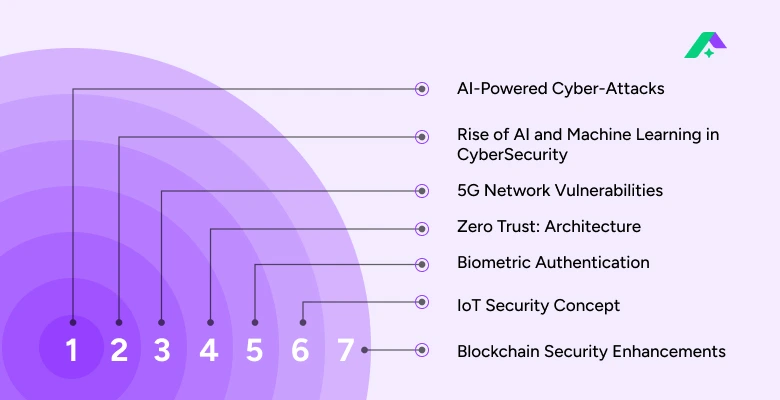In 2025, the cybersecurity landscape had almost evolved into a complex battlefield where cyberthreats are no longer just a concern for large enterprises or IT departments, but a daily reality for everyone connected to the internet. More sophisticated and pervasive than ever before, cyber threats have become a new reality of this digital landscape. From a small business relying on third-party tools to ordinary people like me or remote workers using unsecured Wi-Fi networks, vulnerabilities are worldwide, and cybercriminals are becoming more agile, technologically advanced, and organised than ever before.
With the rise in AI-driven cyberattacks, traditional approaches to cybersecurity are no longer effective. Cybercriminals are using AI to automate attacks. Have the rules of digital engagement been rewritten? What are the stakes? Organisation’s data, personal identity, and, in some cases, national security are also on the list. In this blog, I will explain all the trends in cybersecurity and how to protect your personal information in 2025.
Factors Responsible for the Rise of Cybersecurity
- More connectivity: Growth of IoT devices and the internet
- Economic impact:Data breaches and their financial consequences
- Data expansion: A Wide range of online data
- Technological advancement:Machine learning and AI in cybersecurity
- Compliance demands: Strict regulations for data protection
Top Cybersecurity Trends in 2025 And Staying Protected Online

Trend 1: The Rise of Automotive Cybersecurity Threats
In today’s era, vehicles are more developed with sophisticated software, offering advanced features like engine timing, cruise control, driver assistance, and seamless connectivity. Using technologies like Bluetooth and WiFi to facilitate communication between devices and the vehicle can be a double-edged sword. On one hand, these technologies offer convenience and enhanced functionality, but on the other hand, they create potential entry points for hackers to exploit. If malicious people access a vehicle's systems, they could take control of the car or even eavesdrop on conversations through built-in microphones. As the number of automated vehicles on the road continues to grow, the threat landscape is likely to expand, making it crucial to implement robust cybersecurity measures, especially for self-driving or autonomous vehicles. The stakes are high, and the need for effective security solutions is becoming increasingly urgent.
Trend 2: Smart Phones: An Emerging Target for Cyber Attacks
The expansion of gadgets like mobile devices paved the way for cybercriminals to target, with an increase in malware attacks targeting personal data and mobile banking. Our increasing reliance on smartphones for everything from banking to staying in touch with friends and family has made them a prime target for cyber threats. As our lives become more interconnected with our mobile devices, the potential consequences of a security breach grow more severe. The need for robust mobile security measures has never been more pressing, especially with the emergence of new threats like viruses and malware specifically designed to target smartphones. If we don't take action to protect ourselves, we risk exposing sensitive information and leaving ourselves vulnerable to cyberattacks. The stakes are high, and we must prioritise mobile security to safeguard our digital lives.
Trend 3: Leveraging the power of AI in cybersecurity
AI acts as a backbone in boosting cybersecurity across various industries. Through ML, AI has facilitated the development of automated security capable of performing tasks like threat detection, face detection, and natural language processing. However, malicious activity takes place by utilising this same technology to design sophisticated attacks aimed at breaching security protocols. Despite these barriers, AI-powered threat detection systems respond to rising threats promptly, supporting cybersecurity professionals.
Trend 4: Cloud Security Challenges and Solutions
As more and more organisations move their operations to the cloud, keeping their data safe is a top priority. While cloud providers do a great job of building secure systems, the reality is that vulnerabilities can still creep in, often due to user mistakes, malware infections, or clever phishing scams. To stay ahead of these risks, it's crucial to implement reliable cybersecurity measures, keep a close eye on things and ensure everything is up to date. For teams operating in AWS, periodic security posture reviews help surface misconfigurations like public S3 buckets, overly permissive IAM roles, and exposed services; to benchmark and prioritise remediation, you can get an AWS risk assessment with a 1‑on‑1 expert walkthrough of findings. This way, organisations can protect their sensitive data and avoid the potentially disastrous consequences of a cloud security breach. It's a shared responsibility between the provider and the user, and getting it right requires ongoing effort and attention to detail.
Trend 5: Cybersecurity for IoT in the era of 5G
The expansion of 5G networks is revolutionising the way devices connect and interact with each other, especially in the realm of the Internet of Things (IoT). However, this increased connectivity also brings a heightened risk of security breaches. As IoT devices become more prevalent, they're also becoming more vulnerable to external threats and software flaws. Given the relatively new scenario of 5G network architecture, it's essential that we thoroughly investigate and address potential security weaknesses. To mitigate these risks, manufacturers must focus on designing and building strong hardware and software solutions that can withstand data breaches and network attacks. By doing so, people can get full access to 5G and IoT while keeping their devices and data safe.
Trend 6: Data breaches: An ongoing issue
Data security remains a significant concern for organisations and individuals globally, and even a minor software vulnerability can cause potential threats. Laws like the GDPR and CCPA are spotlighting data protection and privacy, making it clear that strong security measures are no longer optional. To avoid the potentially disastrous consequences of a data breach, organisations need to take a proactive approach to security and ensure they're meeting the requirements of these regulations. It's not just about checking boxes, but about genuinely prioritising the protection and privacy of the people whose data they're handling. By getting this right, organisations can build trust with their customers and avoid the reputational damage from a data breach.
Trend 7: Adopting Automation for Boosting Cybersecurity
Automation plays a vital role in managing extensive volumes of data and streamlining the security process. Security teams are often overwhelmed with work, and that's where automation comes in – it helps them respond quickly and efficiently to new threats. By baking security into the development process, especially in agile environments, we can build more secure software from the ground up. This is particularly crucial for large and complex applications, where security vulnerabilities can have far-reaching consequences. By combining automation and agile development, we can create a more robust and responsive security posture that keeps pace with the evolving threat landscape.
Trend 8: Increasing State-Sponsored Cyber Warfare
As global tensions rise, we're seeing a corresponding increase in state-sponsored cyber attacks. These attacks are targeting the foundations of our societies, including critical infrastructure and sensitive data. High-stakes events like elections are particularly vulnerable, and it's imperative that we take extra precautions to protect them. Looking ahead to 2025, it's likely that we'll see a significant uptick in data breaches and cyber espionage, with state-sponsored actors seeking to exploit sensitive information for political or industrial gain. The stakes are high, and it's crucial that we prioritise robust cybersecurity measures to defend against these threats.
Trend 9: Ransomware Attacks
Ransomware attacks are becoming increasingly targeted, and the impact on industries that rely on specific software systems can be catastrophic. The WannaCry attack on healthcare institutions is a stark reminder of the devastating consequences of inadequate cybersecurity. To avoid falling prey to these threats, organisations need to be constantly on alert and take active steps to protect themselves. This means staying one step ahead of the attackers and implementing tight security measures that can mitigate the risks effectively. By doing so, organisations can reduce their vulnerability to ransomware and minimise the potential damage.
Trend 10: Reducing Insider Threats by Awareness
Human error is still a major contributor to data breaches, particularly when it comes to insider threats. To combat this, organisations need to prioritise employee education and awareness. By providing comprehensive training programs, companies can equip their staff to identify and mitigate potential security risks. This not only helps protect sensitive data but also fosters a culture of cybersecurity awareness within the organisation. When employees are empowered to take ownership of security, companies can significantly reduce the risk of insider threats and minimise the potential damage. It's a crucial step in safeguarding sensitive information and building a robust defense against cyber threats.
Trend 11: Fighting Social Engineering Attacks
Social engineering attacks, such as phishing and identity theft, continue to pose a significant threat to organisations. These attacks exploit human psychology rather than technology, making them particularly difficult to defend against. To reduce the risk of these types of attacks, it's essential to educate employees on how to spot and avoid them. By combining employee training with proactive security measures, organisations can significantly reduce their vulnerability to social engineering attacks and protect their sensitive information. This also includes learning ways to delete personal data online, which can help limit what attackers can find and use.It's a crucial step in building a robust cybersecurity posture that takes into account the human element.
Trend 12: Boosting Security with Multi-Factor Authentication
Multi-factor authentication (MFA) is a powerful tool in the fight against cyber threats. By requiring users to provide multiple forms of verification, MFA adds critical layers of security that make it much harder for unauthorised users to gain access. This approach significantly reduces the risk of breaches and strengthens an organisation's overall cybersecurity defences. In today's threat landscape, adopting MFA is no longer a nice-to-have – it's a must-have for any organisation serious about protecting its systems and data from cyber attacks. By prioritising MFA, organisations can significantly boost their security posture and stay ahead of emerging threats.
Key Takeaways
The cybersecurity landscape of 2025 is a complex and ever-changing field, marked by rapid technological advancements and evolving threats. To stay ahead of the threats, individuals and organisations need to be proactive, continuously learn and adapt, and leverage cutting-edge security measures. By understanding the emerging trends and implementing effective strategies, individuals can protect themselves and their organisations from the increasing sophistication of cyber threats. This enables them to safeguard their digital lives, maintain trust, and ensure a secure online presence. Ultimately, a proactive and informed approach to cybersecurity is key to thriving in this challenging environment.












